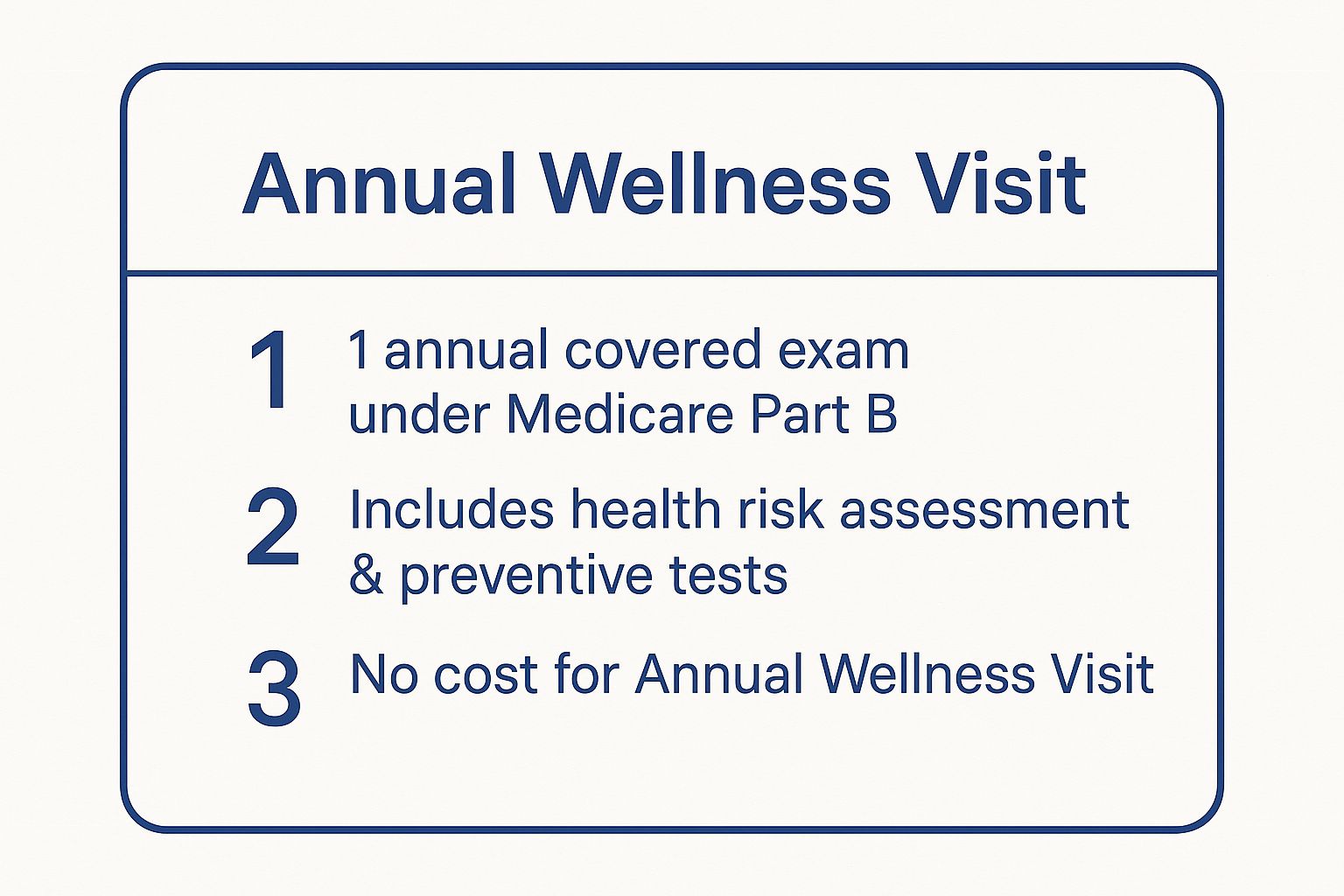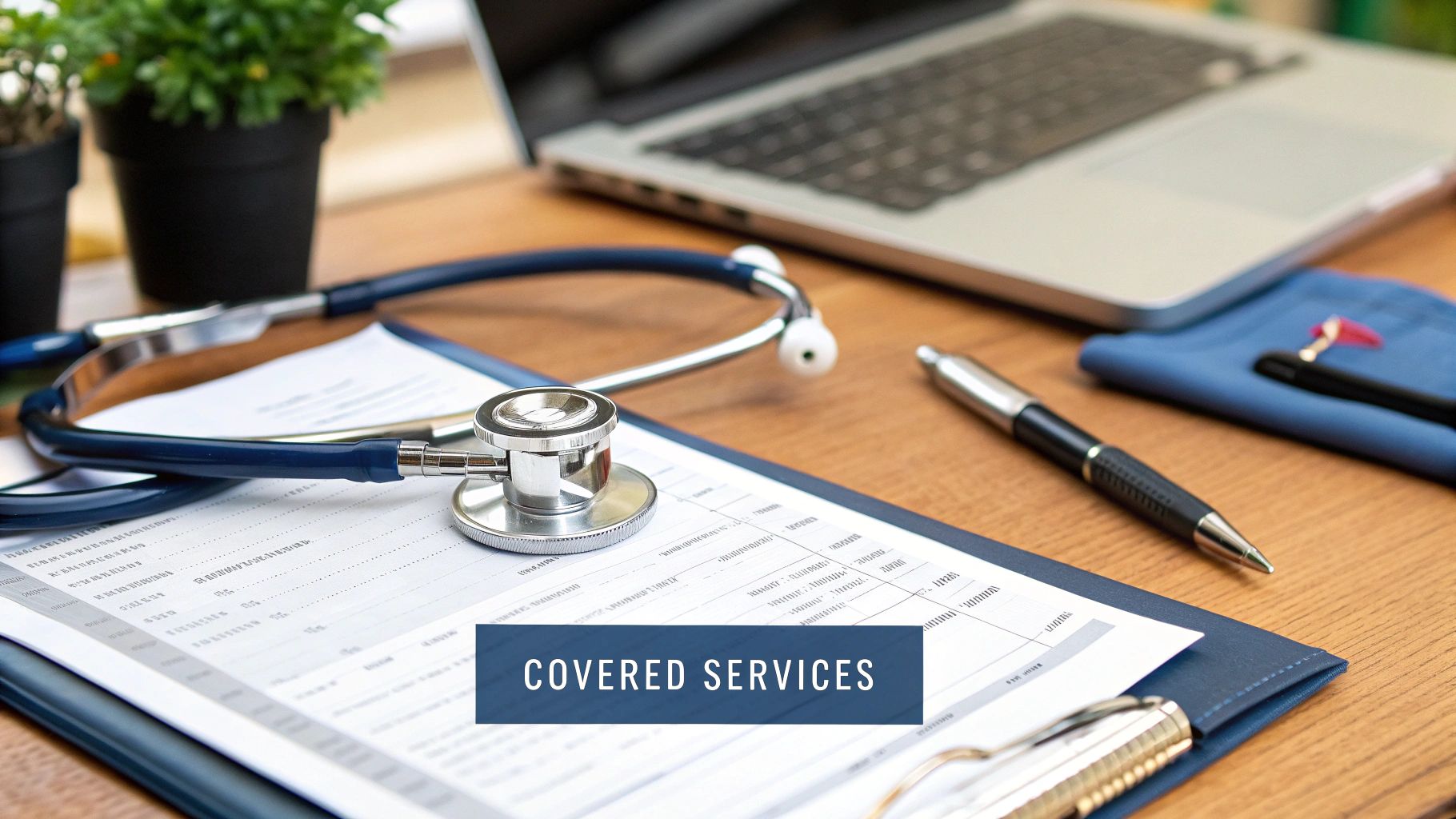Here’s a common question I hear all the time: "Does Medicare cover my yearly physical?"
The short answer is no, and that’s a detail that catches a lot of people by surprise. If you’re used to employer-sponsored health insurance, an annual head-to-toe physical probably feels like a standard part of your healthcare routine. But Medicare does things a bit differently.
Instead of a traditional physical, Medicare offers something called the Annual Wellness Visit (AWV). It's a powerful tool, but its purpose is different. Think of it less as a hands-on exam and more as a strategic planning session with your doctor.
A Different Kind of Annual Checkup
Once you're on Medicare, the whole concept of a "yearly checkup" shifts from reaction to prevention. The goal of the Annual Wellness Visit isn't to find things that are already wrong; it's to create a personalized plan to keep you healthy and catch potential problems long before they start.
This visit is almost entirely a conversation. You'll discuss your health history, current lifestyle, and any risk factors you might have. It’s your chance to map out a health strategy for the year ahead with your trusted doctor.
Traditional Physical vs. Medicare Annual Wellness Visit
To really get a handle on this, it helps to see how the two appointments stack up against each other. A traditional physical is all about the here and now—a hands-on check for current health issues. In contrast, the Medicare Annual Wellness Visit is about looking forward to prevent future ones.
This table breaks down the key differences in what each appointment involves and, most importantly, how it's covered.
| Feature | Traditional Physical Exam | Medicare Annual Wellness Visit (AWV) |
|---|---|---|
| Purpose | To perform a hands-on examination and identify current health issues. | To create a personalized preventive health plan for the coming year. |
| What Happens | Doctor checks vital signs, listens to heart/lungs, and performs physical checks. | Doctor reviews medical history, conducts a health risk assessment, and creates a screening schedule. |
| Coverage | Not covered by Original Medicare. You pay 100% out-of-pocket. | Fully covered by Medicare Part B once every 12 months. |
Understanding this distinction is crucial to avoiding surprise bills and making the most of your benefits.
This image highlights some of the key benefits you get with Medicare's covered wellness visit.

As you can see, the focus is squarely on prevention, screening, and planning—all covered once a year under Medicare Part B at no cost to you.
The most important takeaway? When you call to schedule your yearly appointment, be sure to use the exact phrase "Annual Wellness Visit." If you just ask for a "physical," the office might bill it as a non-covered service, leaving you with the entire bill.
This is just one of the many nuances of navigating your benefits. For more clarity on other common topics, check out our guide with answers to frequently asked questions about Medicare. You can also find more information on various Medicare care services and benefits to help you get the most out of your plan.
What Is the Medicare Annual Wellness Visit?

Here’s something that trips up a lot of people: Medicare doesn't actually cover a traditional yearly physical. Instead, it offers something that can be far more valuable for your long-term health: the Annual Wellness Visit (AWV).
Think of it this way: a physical is like a mechanic checking your car's engine and tires. The Annual Wellness Visit, on the other hand, is like sitting down with a route planner to map out the safest, most efficient journey for the years ahead. It’s less about a hands-on exam and more about building a personalized roadmap to keep you healthy.
The whole point is to move from reactive care—only seeing a doctor when something is wrong—to proactive health management. During this visit, you and your doctor collaborate on a prevention strategy tailored specifically to you, helping you get out in front of potential health concerns.
The Core Components of Your Visit
An Annual Wellness Visit isn’t just a casual chat; it’s a structured appointment designed to give your doctor a 360-degree view of your health and potential risks. It’s all about methodical, long-term planning.
So, what actually happens during the visit? You can expect to cover several key areas:
- Health Risk Assessment (HRA): You'll fill out a detailed questionnaire about your health history, daily habits, and lifestyle.
- Medical and Family History Review: Your doctor will go over your personal and family medical records, looking for any hereditary risks that need attention.
- Cognitive Function Check: The doctor will observe you during your conversation to look for any early signs of cognitive impairment like dementia or Alzheimer's.
- Preventive Screening Schedule: This is a big one. Based on your unique risk factors, your doctor will create a screening schedule for the next 5-10 years.
This forward-looking approach is what makes the AWV so powerful. It’s not just about how you feel today; it’s about creating a concrete plan to keep you well for the next decade.
A Proactive Approach to Your Health
The federal government introduced the Annual Wellness Visit in 2011 because they saw a critical need for this kind of preventive care. They made it a no-cost benefit to encourage people to focus on screenings, manage chronic conditions, and plan for their future care needs.
This visit is a cornerstone of your long-term health strategy. You'll talk about everything from home safety and fall risks to screenings for depression—all without the need for a traditional, hands-on physical exam. By preparing for this conversation, you can turn a simple doctor's visit into a powerful tool for a healthier life. We dive deeper into this kind of proactive planning in our comprehensive Medicare planning guide.
Understanding the Welcome to Medicare Visit

Before you can get into the rhythm of yearly check-ins, Medicare has a required first step. It's a one-time appointment called the "Welcome to Medicare" preventive visit, and frankly, it's a common point of confusion for folks new to the system.
Think of it as a health orientation. This visit is all about establishing a starting point with your doctor as you enter the Medicare system, setting the stage for all your future preventive care. It’s a foundational meeting.
Here's the most important thing to remember: this is a one-time benefit. You have a specific window—the first 12 months after your Medicare Part B coverage starts—to get this done. If you miss that deadline, you forfeit the chance for this covered visit.
What Happens During This Initial Visit
The "Welcome to Medicare" visit is a bit more hands-on than the wellness visits that follow, but don't mistake it for a traditional head-to-toe physical. The real goal is to gather crucial health information and sketch out an initial plan for keeping you healthy.
During the appointment, your doctor will cover a few key things to get a baseline for your health:
- Record Vital Information: They'll check basics like your height, weight, and blood pressure.
- Conduct a Simple Vision Test: Just a quick screening to get an idea of your eyesight.
- Review Your Health History: This is a conversation about your medical background and lifestyle to get the full picture.
- Discuss Preventive Services: You'll talk about what screenings, shots, and other preventive care you might need down the road.
This visit is the starting point. The information gathered here becomes the foundation upon which your doctor will build your personalized prevention plan during each subsequent Annual Wellness Visit.
The Purpose and Timing Are Key
Once you've completed this introductory meeting, you're officially eligible for your yearly Annual Wellness Visits. In a way, the "Welcome to Medicare" visit "unlocks" this recurring benefit. Without it, you can't schedule your first AWV.
It’s all about the sequence. Here’s how it works:
- Enroll in Medicare Part B: The clock starts ticking on your 12-month window for the "Welcome to Medicare" visit.
- Schedule Your "Welcome to Medicare" Visit: Make sure you get this appointment done within those first 12 months.
- Schedule Your First AWV: After a full year has passed since your "Welcome to Medicare" visit, you can schedule your first Annual Wellness Visit.
Getting this timeline right ensures you don't miss out on a valuable part of your new benefits. It’s the official kickoff to taking a proactive role in your health with Medicare, paving the way for years of structured care designed to catch potential issues early.
How to Avoid Surprise Costs for Your Doctor Visit

This is where so many people get tripped up. The line between a preventive wellness visit and a diagnostic appointment is surprisingly thin, and crossing it is what often leads to those dreaded surprise medical bills.
You have to understand this distinction, because the moment your free Annual Wellness Visit (AWV) pivots to address a specific health problem, it stops being just a preventive service.
For example, let's say you're at your wellness visit and you casually mention some knee pain you've been having. If your doctor then starts a hands-on examination of your knee, orders an X-ray, or writes you a new prescription for it, those services are considered diagnostic. They're going to be billed to Medicare separately from your free visit.
That quick shift from prevention to diagnosis is what can trigger out-of-pocket costs. As soon as those diagnostic services are billed, they fall under your Medicare Part B deductible and coinsurance. Suddenly, a visit you thought was free now has a bill with your name on it.
The Shopping Cart Analogy
Think of your doctor’s visit like a trip to the grocery store. Your Annual Wellness Visit is a special coupon for one specific, pre-paid item that’s 100% free. You can pop that item in your cart and head straight to the checkout without opening your wallet.
But what happens if you start adding other things to your cart? Maybe you grab that prescription for your knee or the doctor orders a lab test for a new concern. Those extras aren't covered by your free coupon.
When you get to the checkout counter, you’ll have a separate bill for everything else you added. It’s those extra services that lead to surprise costs.
The moment your conversation shifts from general prevention to diagnosing or treating a new or existing health issue, you're essentially adding items to your medical shopping cart. Those items will be billed separately.
How to Communicate with Your Doctor's Office
The absolute best way to sidestep a surprise bill is to be crystal clear with the doctor's office—both before and during your appointment. You're in the driver's seat here. You can control the conversation and make sure the visit stays focused on preventive care.
Here are a few simple, practical steps you can take:
- Be Specific When You Schedule: When you call to book the appointment, use the exact phrase, "I'd like to schedule my Medicare Annual Wellness Visit." Don't just say "physical" or "check-up," as those terms are too general.
- State Your Intent: Let the scheduler know you only want to cover the preventive services included in the AWV. If you have another health issue to discuss, ask if it would be better to book a completely separate appointment for that.
- Confirm When You Arrive: At the check-in desk, just double-check with the staff. A quick, "I'm just confirming this is for my Annual Wellness Visit, correct?" can save a lot of headaches later.
- Speak Up During the Visit: If the conversation starts drifting and your doctor begins diagnosing a new problem, it's perfectly okay to politely interject. You can say something like, "For today, I'd really like to stick to my free wellness visit. Can we please schedule another appointment to talk about my knee pain?"
Getting a handle on how payment structures like coinsurance and copays work is also a huge part of managing healthcare costs. To dive deeper, check out our guide on coinsurance vs. copay. And for a broader perspective, exploring different strategies for avoiding medical bills can give you even more tools to protect your finances.
How to Maximize Your Medicare Preventive Care
Think of your Annual Wellness Visit (AWV) as more than just a yearly check-in. It's really the command center for your entire health strategy, helping you stay one step ahead of any potential problems.
To get the most out of this powerful, free benefit, you have to show up prepared. It’s like a business meeting for your health—you wouldn't walk in without an agenda. Before your appointment, take a few moments to pull together a clear, organized list of your health information.
This simple act of preparation changes the entire dynamic. It turns a passive check-up into an active planning session. Your doctor's time is limited, so having everything ready ensures you spend every minute focused on what truly matters for your well-being.
Your Pre-Visit Checklist
When you come prepared, you give your doctor a complete and accurate picture of your health. A good list also keeps you from forgetting to mention that one nagging symptom or question that’s been on your mind.
Here’s a quick rundown of what to bring:
- A Full Medication List: Don't forget anything! This means prescriptions, over-the-counter drugs, vitamins, and even herbal supplements. Make sure to note the dosage and how often you take each one.
- List of Your Healthcare Providers: Jot down the names and contact info for any other doctors you see, like your heart specialist or eye doctor.
- Your Top Health Concerns: Write down any questions you have, no matter how small they might seem. This is your chance to get answers and peace of mind.
Your Annual Wellness Visit is the perfect opportunity to create a personalized schedule for all your other preventive care. It’s the visit that organizes all the other visits.
Turning Your Visit into a Comprehensive Health Plan
The real power of the AWV is what it sets in motion for the rest of the year. It's not just about what happens in the exam room; it’s about creating a roadmap for the next 12 months. More people are catching on to this, with AWV participation jumping from 45% in 2020 to 60% in 2022. You can learn more by checking out these preventive care trends among Medicare beneficiaries.
Use this dedicated time with your doctor to coordinate all the other $0-cost preventive services that Medicare offers. It's the perfect opportunity to ask the big questions and get everything on the calendar.
During your visit, be sure to ask your doctor:
- "Based on my history, what cancer screenings do I need this year?" This could be anything from mammograms and colonoscopies to screenings for prostate or cervical cancer.
- "Which vaccinations are recommended for me?" You know about the annual flu shot, but you might also be due for a pneumonia or shingles vaccine.
- "What other preventive tests should we schedule?" Depending on your specific risk factors, this could include bone density scans or screenings for conditions like diabetes or heart disease.
By asking these simple questions, you turn your Annual Wellness Visit from a routine chat into a powerful planning tool. You’ll walk out of that appointment with more than just a snapshot of your current health—you’ll have a concrete, actionable plan for the next 12 months, making sure you take full advantage of every preventive benefit you're entitled to.
Do Medicare Advantage Plans Cover Physicals?
When you step into the world of Medicare Advantage, the rules for physicals can change completely. While Original Medicare is pretty strict about not covering a routine annual physical, Medicare Advantage plans often march to the beat of a different drum.
Think of it this way: Original Medicare is the foundational, government-run program with a set menu of benefits. Medicare Advantage plans, offered by private insurance companies, have to provide that same menu—but they often add extra perks to stand out. A traditional, head-to-toe annual physical is one of their most popular additions.
In fact, many Advantage plans highlight a yearly physical as a $0 copay benefit. It’s a huge draw for members who are used to getting this kind of checkup every year and want to continue doing so.
Confirming Your Plan's Coverage
Here’s the catch: because private companies run these plans, the benefits are all over the map. One plan might offer a full physical at no charge, while another might not cover it at all. So, the first rule is to never assume. You have to check what your specific plan offers.
Your best friend here is the Evidence of Coverage (EOC) document. This is your plan’s official rulebook, and it spells out every single covered service. Dig into the sections on "preventive services" or "annual physicals" to see precisely what's included and if you'll have any out-of-pocket costs.
The golden rule for Medicare Advantage is simple: always verify before you visit. A quick phone call can save you from an unexpected bill.
Before you book an appointment, make sure you take these steps:
- Call Your Plan Provider: This is the quickest way to get a straight answer. Ask them point-blank, "Does my plan cover a traditional annual physical exam, separate from the Medicare Annual Wellness Visit?"
- Confirm In-Network Status: Advantage plans use provider networks, like HMOs or PPOs. You absolutely must confirm your doctor is in-network, or you could be on the hook for a much bigger bill.
- Get It in Writing (or Close to It): When you call, jot down the date, the name of the person you spoke with, and a reference number for the call. This little bit of documentation can be a lifesaver if there's a billing dispute later.
Getting a handle on these details is vital, especially when you're deciding which type of coverage is right for you. If you’re thinking about your options, you can learn more about how to change from Medicare Advantage to Medigap and see what that process looks like.
Got Questions About Your Medicare Physical? We’ve Got Answers.
It's completely normal to have questions about Medicare's preventive care. The rules around scheduling, what’s covered, and what isn’t can feel a bit confusing. Let’s clear up a few of the most common questions so you can feel confident getting the care you deserve.
When Can I Schedule My Next Wellness Visit?
This is probably the number one question people have. You're eligible for one Annual Wellness Visit (AWV) every 12 months. But here’s the key detail that often trips people up: 11 full months must pass after your last wellness visit before you can schedule the next one.
So, if you had your last AWV on June 15th, you’ll need to wait until at least May 16th of the following year to have your next one. Just remember this visit is different from the one-time "Welcome to Medicare" check-up you get when you first enroll.
What Should I Bring to My Appointment?
Coming prepared makes a huge difference and helps your doctor get a complete picture of your health. Think of it as doing a little homework to make the most of your time together.
Here’s a quick checklist of what to bring:
- A full list of your medications. Don't forget anything! This includes prescriptions, over-the-counter medicines, vitamins, and any herbal supplements.
- Your healthcare team's contact info. Jot down the names and phone numbers of any other doctors or specialists you see regularly.
- A list of your questions. Before you go, think about any health concerns or questions that have been on your mind and write them down so you don't forget.
What If I Get a Surprise Bill?
First off, don't panic if you get a bill you weren't expecting for your wellness visit. The first step is to look closely at the statement and see what services you were charged for. If your doctor treated a specific new or existing health problem during the visit (like diagnosing a new rash or adjusting your blood pressure medication), those services might be billed separately.
If the charges still don't make sense, your next step should be a quick call to the doctor's billing office to ask for a clear explanation.
Even with these benefits available, a surprising number of people don't take advantage of them. One study found that only 1.7% of eligible patients initially completed their AWV. After some simple patient outreach explaining what the visit was for, that number more than doubled to 3.8%!
This just goes to show how important it is to understand your benefits. You can read more about the research on increasing AWV completion rates on PMC. By asking the right questions and staying informed, you can make sure you’re getting the preventive care you’re entitled to, year after year.
Navigating insurance options can be complex, but you don't have to do it alone. My Policy Quote is here to help you find the right coverage to fit your unique needs. Get your free, no-obligation quote today!


